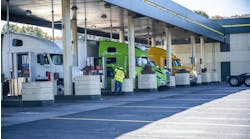Why in the world would anyone be upset that the cost of fuel is down? Because it can make it easy to achieve secondary metrics and allow you to take your eyes off the ball that is important.
If you are responsible for fuel costs, you probably had a wonderful 2nd half of 2014. While you probably had some arguments about metrics for 2015, you probably successfully argued that fuel costs won’t stay low and got your management to agree to some numbers similar in size to the first half of 2014. Now, at least for the first few months of 2015, you will consistently beat the numbers, almost without having to do anything. One side effect might hurt you, though. Someone may notice that some revenue goes down because you had fuel surcharges with some customers. Now, depending on the way your surcharge was written, with fuel costs down, revenue goes down as well.
But, the real measure of success in managing fuel is more complicated. It’s load-specific fuel consumption. Huh? What is that? It’s not gallons of fuel, it’s not dollars of fuel, it’s not miles per gallon--it’s fuel used per ton of freight hauled. What? Who came up with that? Well, you, the fleets did. And it’s now what EPA and NHTSA use for setting regulations.
Usually, it’s the maintenance guys who are responsible for the fuel in a fleet. It’s the logistics guys that are responsible for the amount of freight, or weight of freight hauled. I’ll bet most fleets don’t even have a way of calculating this number.
FedEx has publicly indicated a goal of improving fuel efficiency 30% by 2020 compared to what they did in about 2008. I believe this is measured in miles per gallon. Separately, FedEx has instituted volume-based pricing in addition to pricing based on weight. Twice this last month, I watched people use a tape measure to figure out the size of a package I was shipping, in addition to them weighing it. This should, create more revenue for bulky, oversized yet underweight packages. FedEx and others have a tough job of packing things into trucks efficiently. I hope they find a way to measure load-specific fuel consumption.
Walmart gets closer to the mark with its measure of fleet efficiency, which they define as cases shipped per gallon burned. Their goal is to double fleet efficiency by 2016 compared to where they started in 2006. They track improvements in miles per gallon for their vehicles, loading improvements (put more pallets into the trailer by double stacking them or turning them) and routing improvements that reduce the miles driven. As for any fleet, eliminating unloaded miles and taking more backhauls is a way to improve operations. Walmart also presses suppliers to put more on a pallet by reducing packaging and using more concentrated items, such as detergents for clothes washing. But, I have yet to see a presentation from them where they showed the improvement in load-specific fuel consumption. I hope they find a way to measure load-specific fuel consumption.
You get what you measure is a management truth. So, let’s start measuring what is being regulated.


